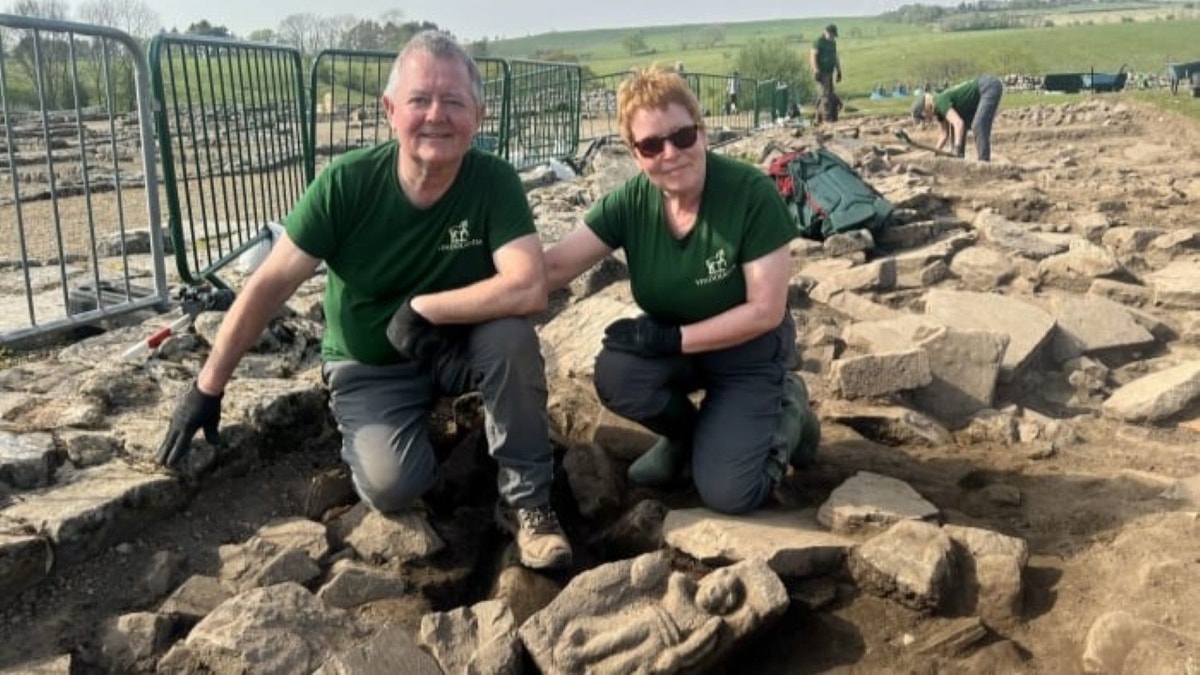NEWYou can now listen to Fox News articles!
Volunteers recently unearthed an ancient depiction of a Roman goddess while digging near a historic British landmark.
The sandstone carving was found at Vindolanda, a fort in Northumberland, near Hadrian’s Wall. In a May 21 press release, the Vindolanda Trust identified the depiction as Victoria, the goddess of victory in Roman mythology.
The artifact was uncovered by Jim and Dilys Quinlan, a couple from Merseyside who have volunteered in countless excavations over the past two decades. The pair found the artifact in a pile of rubble near former infantry barracks.
ARCHAEOLOGISTS UNEARTH STRANGE HEAD DEPICTING ROMAN GOD BENEATH CATHOLIC BASILICA
Pictures show the proud volunteers smiling next to their discovery in the rubble pile. The organization said Victoria was the counterpart of the Greek goddess Nike, and was worshiped in Ancient Rome.
“Victoria was highly revered by the Ancient Romans. During times of war, she was often credited for battlefield success,” the statement read.
Hadrian’s Wall was built under the Ancient Romans, who successfully invaded Britain in 43 A.D. under Emperor Claudius. Previous attempts by Julius Caesar failed, and the Romans were able to establish long-lasting British settlements in the first century A.D.
Under Emperor Hadrian, Hadrian’s Wall began construction in 122 A.D. to protect the northern border of the province of Brittania from the Picts, who lived in southern Scotland.
“It is highly likely that this stone would have originally been brightly painted.”
The barracks were built in 213 A.D., which was a “tumultuous time” due to the Severan wars ending shortly earlier, according to the Vindolanda Trust.
ANCIENT ROMAN HELMET TURNS UP IN UNUSUAL LOCATION: ‘EXCEPTIONALLY RARE’
“The barracks were once adorned with a large ornamental arch and gate, precisely the location where an inscription may have been present,” the statement noted.

“The relief of Victory is poignant, representing the end of the war and the establishment of the fort at the site.”
Experts believe that the recently discovered stone was part of a significantly larger work, and may have been painted in vibrant colors.
For more Lifestyle articles, visit foxnews.com/lifestyle
“It is highly likely that this stone would have originally been brightly painted,” Vindolanda Trust curator Barbara Birley observed.
She added, “We will be working with our specialists to see if any traces of the pigment remain, so for now the relief is being stored unwashed ready for that further analysis.”
In a statement, Vindolanda Trust director of excavations Andrew Birley said that similar finds from Roman Britain are “increasingly rare these days.”
“[T]he beautifully carved figure vividly reminds us that Roman forts were not simply utilitarian, they had grandeur and, of course, the symbolism was a vital part of the culture here for the soldiers almost 2,000 years ago,” the expert noted.
Birley added, “I am also delighted for Jim and Dilys for their discovery. It is just reward for their 21 years of hard work and dedication to this site.”
The piece is set to go on display at the Vindolanda museum next year.
Due to the vast amount of influence the Ancient Romans had in the British Isles, Roman-era discoveries are not unheard of, to be sure.
An archaeologist recently found an unusual eight-sided Ancient Roman ring in a former drainage ditch in Lincolnshire.
A few months earlier, a Roman grave filled with gypsum was found during a highway construction project in England.
Read the full article here

